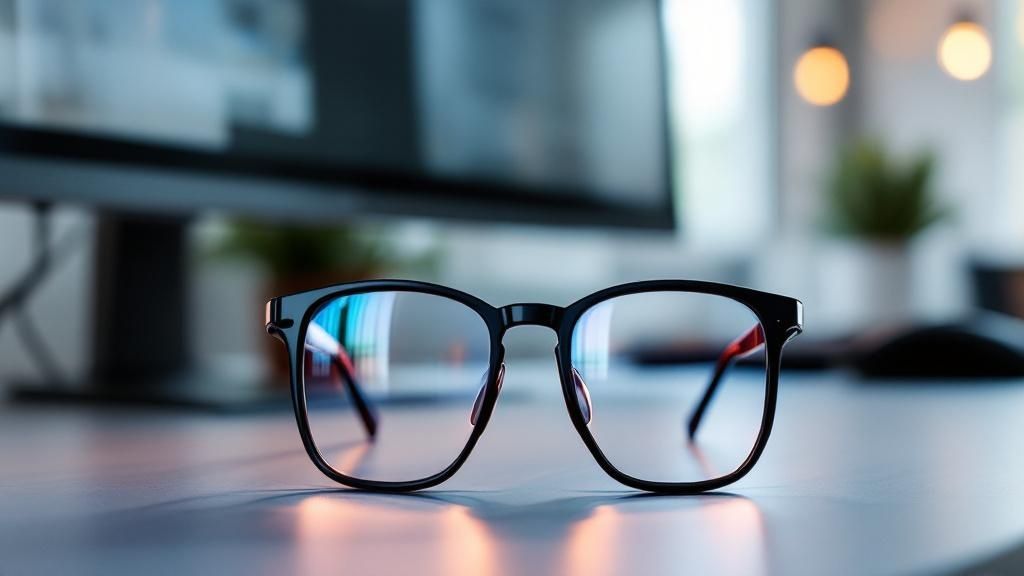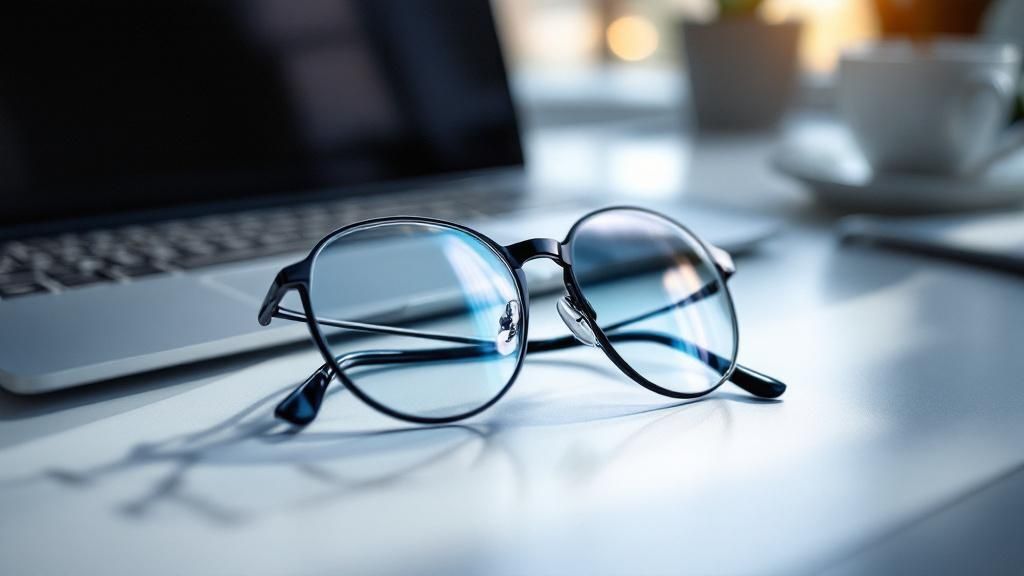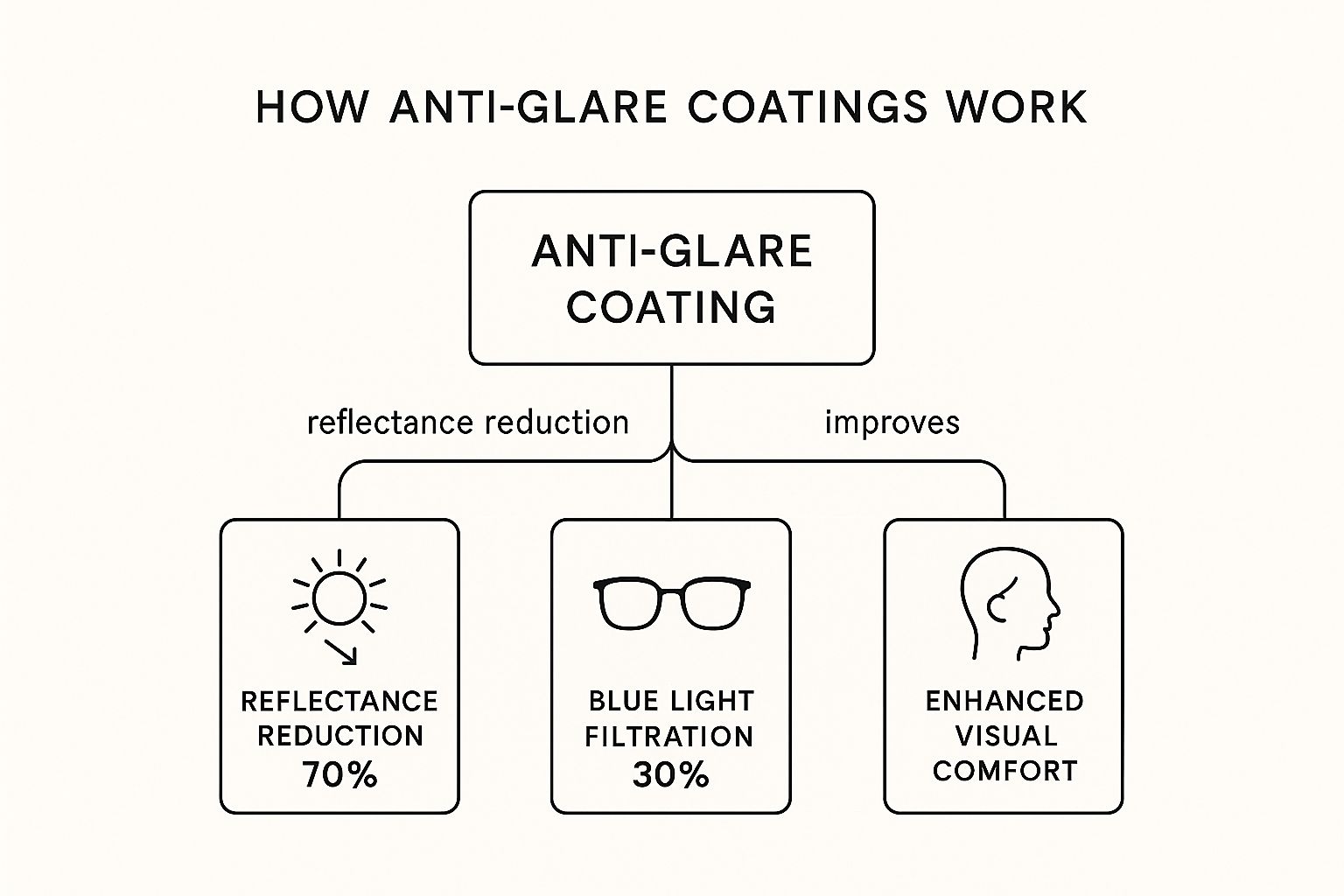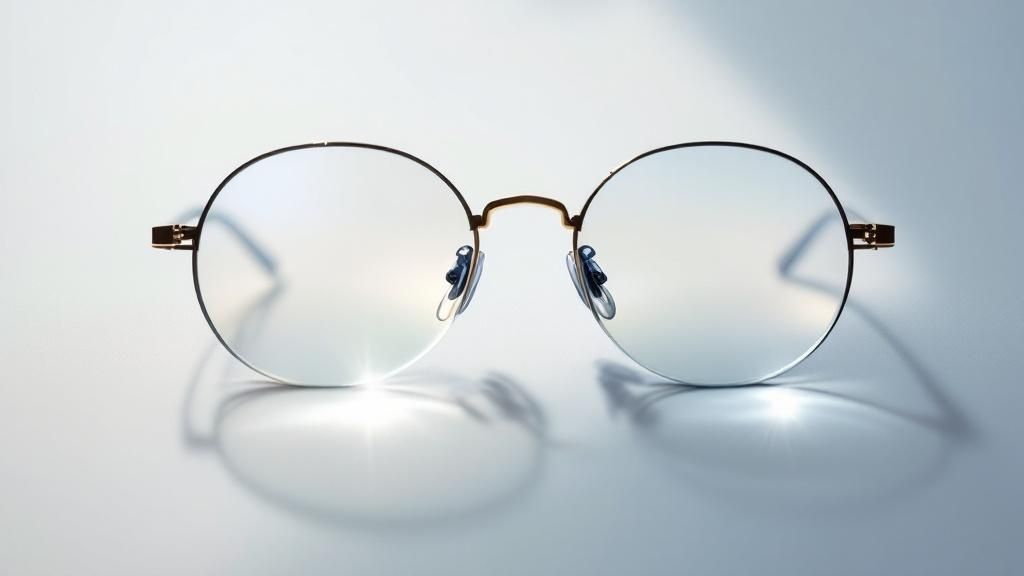
Anti Glare Glasses for Computer Use Explained
If you spend a good chunk of your day staring at a computer, you know the feeling. That dull, nagging headache behind the eyes. The tired, gritty sensation that just won’t go away. This is digital eye strain, and the most straightforward fix is a pair of anti glare glasses for computer use. Think of them as a shield for your eyes, cutting through the harsh reflections from your screen and overhead lights so your eyes can finally relax and focus without working so hard.
Your Essential Tool for Digital Eye Strain
 Picture your computer screen as a slightly distorted mirror. It's constantly bouncing back light from everywhere—the lamp on your desk, the window behind you, even the bright ceiling lights. To see what's actually on the screen, your eyes have to fight through all that visual noise.
Picture your computer screen as a slightly distorted mirror. It's constantly bouncing back light from everywhere—the lamp on your desk, the window behind you, even the bright ceiling lights. To see what's actually on the screen, your eyes have to fight through all that visual noise.
This constant battle is what causes digital eye strain, a whole collection of symptoms like blurred vision, tired eyes, and tension headaches. It's more than just an annoyance; it slowly chips away at your productivity and makes screen time feel like a chore. This is the exact problem anti glare glasses are built to solve.
How Anti Glare Technology Works
So, what's the magic behind them? It all comes down to a microscopic, invisible layer on the lenses called an anti-reflective (AR) coating. This coating is engineered to manipulate light waves, effectively canceling out the ones that create glare.
Instead of reflections bouncing off the lenses and into your eyes, they're neutralized. The result is a much cleaner, crisper view of your screen. Your eyes get more of the light that matters—the actual content you're trying to see—and less of the distracting visual static that causes fatigue. It’s a simple concept, but the relief is immediate, allowing you to focus comfortably for much longer.
Key Insight: Anti glare glasses aren't just an accessory; they're a fundamental productivity tool. By making you more comfortable visually, they directly help you work, study, or game for longer without the physical drag of eye fatigue.
This isn't just a niche idea anymore. The global computer glasses market was valued at around $3.04 billion in 2024 and is expected to climb to $5.5 billion by 2032. That growth is fueled by a huge number of us—professionals, students, and gamers—who depend on screens and are actively looking for ways to make that time more comfortable. You can find more data on this trend and what's driving it.
To really understand the impact, it helps to see a direct comparison of the problems and solutions.
How Anti Glare Glasses Combat Digital Eye Strain
| Symptom of Digital Eye Strain | How Anti Glare Glasses Help | The Primary Benefit |
|---|---|---|
| Blurry or Unclear Vision | Eliminates reflections from the screen and surrounding light sources. | Your eyes can focus on the screen content without interference, leading to sharper vision. |
| Headaches & Eye Fatigue | Reduces the constant micro-adjustments your eye muscles make to fight glare. | Less muscle tension around the eyes means fewer headaches and reduced overall fatigue. |
| Squinting to See Clearly | Increases the amount of clear, useful light reaching your eyes. | You don't need to squint to get a sharp image, which relaxes your facial muscles. |
| Dry or Irritated Eyes | By reducing strain, you may find you blink more normally. | Helps maintain natural eye moisture and reduces that gritty, dry feeling. |
As you can see, the glasses work by directly counteracting the specific issues that cause discomfort.
Who Benefits Most from These Glasses
Honestly, anyone staring at a screen for a few hours a day will feel a difference. But for some people, it’s a total game-changer. These are the folks who spend the better part of their day locked onto a display, making them prime candidates for serious digital eye strain.
- Office Professionals: If you're an accountant, project manager, or anyone else working under fluorescent office lights, you know the headache struggle is real. Anti glare glasses cut through that harsh lighting to improve focus.
- Students and Educators: Long hours of online classes, research papers, and grading can be draining. These glasses make those marathon study sessions far more comfortable.
- Gamers and Streamers: When you need peak visual performance and concentration for hours, screen glare is the enemy. Eliminating it isn't just about comfort; it's a competitive edge.
The Technology Behind Anti-Glare Lenses

So, what’s the secret behind effective anti-glare glasses for computer use? It’s not about the frame or the basic plastic of the lens. The real magic lies in a microscopic, high-tech film applied right onto the lens surface. This is the anti-reflective (AR) coating, and it's a brilliant piece of optical physics.
Think of an AR coating as noise-canceling headphones, but for your eyes. Those headphones generate opposite sound waves to silence distracting background noise. In a similar way, an AR coating uses carefully stacked layers to cancel out the distracting light waves that bounce off your lenses. This visual "static" comes from everywhere—your monitor, overhead lighting, even the window behind you.
By getting rid of that interference, the glasses allow a much cleaner, sharper image to reach your retina. Your eye muscles can finally stop working overtime to filter out all that visual noise, leading to a far more relaxed and comfortable experience.
How Anti-Reflective Coatings Work
An AR coating isn't just one simple layer. It’s actually a precise stack of multiple, incredibly thin layers of metallic oxides. Each one is meticulously engineered to interfere with a specific wavelength of light.
Here's a way to picture it: when light hits a normal, uncoated lens, a good chunk of it reflects off both the front and back surfaces. Our eyes see those reflections as glare. The AR coating’s multiple layers create what physicists call destructive interference. As light waves bounce off the different layers, they essentially cancel each other out. This allows far more light to pass straight through the lens to your eye where it belongs.
The difference is staggering. A standard plastic lens might reflect around 8% of incoming light. A high-quality AR-coated lens, on the other hand, can slash reflections to less than 1%. That major boost in light transmission is why everything appears brighter and more defined.
Key Takeaway: The whole point of an AR coating is to let in the "good" light (the information you're trying to see) while eliminating the "bad" light (the reflections that cause eye strain). It uses physics to turn light waves against each other to achieve this clarity.
More Than Just Glare Reduction
These days, the best anti-glare computer glasses come with coatings that do a lot more than just handle reflections. Modern coatings are multi-functional, offering a whole suite of benefits that protect your lenses and keep your vision clear. These added features are what make them truly practical for daily life.
These advanced treatments are usually built right into the AR coating stack, creating one tough, integrated surface with several jobs. Here’s what you’ll often find:
- Hydrophobic Properties: This layer repels water. Rain or splashes bead up and roll right off instead of smearing and blurring your vision.
- Oleophobic Properties: This is an oil-repelling treatment. It makes it much harder for fingerprints, smudges, and skin oils to stick, keeping your lenses cleaner for longer.
- Anti-Static Properties: This feature helps repel dust and other fine particles—a lifesaver in office or home environments where dust is a constant.
- Scratch Resistance: A durable hard coat is almost always included as the top layer. It protects the delicate AR layers underneath from the scuffs and scratches of everyday use.
This push for more capable eyewear is clear from the market's growth. In 2023, the anti-glare glasses market was valued at about $4.5 billion. Experts project it will nearly double to roughly $7.8 billion by 2032, growing at a rate of about 6.5% each year. This trend shows just how much people appreciate these innovations in lens technology. You can discover more insights about the anti-glare market and what's driving it.
When you put it all together, this combination of technologies results in a lens that isn't just better for easing computer eye strain, but is also far more durable and convenient for everything else you do. You get clearer vision with a lot less hassle.
Anti-Glare vs. Blue Light Filtering Lenses
When you start looking for anti-glare glasses for computer use, it's really easy to get tangled up in the terminology. You'll see "anti-glare" and "blue light filtering" used almost interchangeably, but they're two completely different technologies built to solve two very different problems. Getting this distinction right is the key to picking the best protection for your eyes.
Let's use an analogy. An anti-glare coating is like a perfectly clean, totally invisible window pane. Its only job is to get rid of those distracting reflections that bounce off the lens surface, giving you a much clearer, more direct view. It’s tackling the visual “noise” from overhead lights, the reflection of your own screen, and any other light source bouncing around the room.
A blue light filter, on the other hand, is more like a selective shade pulled down over that window. It isn't trying to stop all reflections. Instead, it’s designed to specifically target and cut down the amount of high-energy visible (HEV) blue light that passes through the lens and reaches your eye.
Solving Different Visual Problems
An anti-glare coating directly addresses the physical strain that comes from trying to focus through a mess of reflections. When your eyes are constantly fighting that visual clutter, your eye muscles have to work overtime. This leads directly to fatigue, tension headaches, and just plain difficulty concentrating. The main payoff for anti-glare is crystal-clear vision and pure comfort.
Blue light filtering is all about targeting a specific slice of the light spectrum. While the research is still evolving, this type of light has been linked to disrupting our natural sleep-wake cycle, also known as our circadian rhythm. By filtering it out, especially when you’re on screens in the evening, these lenses aim to support better sleep. You can dive deeper into the science behind blue light and its health effects by exploring various blue light studies and information.
For the most complete protection from screen-related discomfort, you really want both of these technologies working together.
This image really helps break down how a modern lens coating often combines these functions for total visual comfort.
 As you can see, a high-quality coating enhances comfort by primarily knocking out reflections while also filtering a portion of blue light.
As you can see, a high-quality coating enhances comfort by primarily knocking out reflections while also filtering a portion of blue light.
A Two-Part Solution for Screen Use
To put it as simply as possible, one technology deals with the quality of light getting to your eyes, while the other deals with the clarity of your vision itself.
- Anti-Glare (Anti-Reflective): This is all about visual comfort and sharpness. Its job is to stop reflections from bouncing off your lenses, which means less squinting and less strain on your eye muscles. It's a must-have for anyone who gets distracted by their own reflection in their glasses.
- Blue Light Filtering: This is about managing your light exposure. Its job is to dial down the intensity of a specific light wavelength, which may help keep your body's internal clock in check, particularly when using screens at night.
Key Insight: Choosing between them isn't an either/or decision. The best anti-glare glasses for computer use typically incorporate both. The anti-reflective coating ensures your vision is crisp and free from distracting glare, while the blue light filter manages your exposure to potentially disruptive light waves.
Ultimately, you should think of these two features as teammates. Anti-glare clears the path for clean, unobstructed vision, and blue light filtering fine-tunes the light that travels down that path. Together, they offer a solid defense against the common headaches of our screen-filled lives, letting you work, study, or play with a whole lot more ease.
How to Choose the Right Anti Glare Glasses
Choosing the right pair of anti glare glasses for computer use is about so much more than just picking a frame style you like. If you're serious about getting relief and improving your focus, you need to look past the aesthetics and focus on what really counts: the lens quality, the comfort of the fit, and the specific features that address your daily screen time habits. Think of it as an investment in your well-being.
It’s a bit like buying a good kitchen knife. A cheap one might slice a tomato or two, but a well-crafted, balanced knife makes the work effortless, performs reliably for years, and is a joy to use. The same logic applies here. A smart choice now will pay dividends in a clearer, more comfortable digital life for years to come.
Lens Quality and AR Coating
The real magic of any good pair of computer glasses lies in the anti-reflective (AR) coating. But here’s the thing: not all AR coatings are the same. A basic, off-the-shelf coating might offer some minimal glare reduction, but they often lack durability and can scratch, smudge, or peel way too easily. You’ll be constantly cleaning them, and they won't last.
Premium AR coatings, on the other hand, are a different beast entirely. They're built using multiple, precisely engineered layers that provide far superior reflection-blocking power and toughness. These advanced coatings are also designed to be scratch-resistant, smudge-proof, and water-repellent, keeping your view pristine. Spending a little more on a high-quality coating means your glasses will last longer and simply work better, day in and day out.
Key Insight: A superior AR coating is the single most important feature for beating glare. It directly impacts both how clearly you see and how long your glasses will last, making it a truly worthwhile investment.
Prescription vs. Non-Prescription Lenses
Your next big decision comes down to your personal vision needs. Do you need a prescription or not?
- Non-Prescription (Plano) Lenses: If you’re blessed with 20/20 vision and don't need any corrective eyewear, you can go for non-prescription lenses. Often called "plano" lenses, they have zero magnification but come fully equipped with the anti-glare and blue light filtering tech you need.
- Prescription Lenses: If you already wear glasses or contacts to correct for nearsightedness, farsightedness, or astigmatism, you’ll absolutely want to have your prescription built into your computer glasses. This ensures you aren't just swapping one vision problem for another.
Getting this right is critical. Trying to use non-prescription glasses when you actually need vision correction will just add another layer of eye strain, completely defeating the purpose of getting them in the first place.
The Importance of a Comfortable Frame and Fit
You could have the most technologically advanced lenses on the planet, but if the frames pinch your nose or slide down your face, you won't wear them. It’s that simple. Since you’ll likely have these glasses on for hours at a time, a comfortable and secure fit is non-negotiable.
Look for frames made from lightweight yet sturdy materials like high-quality acetate or titanium. Pay close attention to how the bridge fits on your nose and how the temple arms rest behind your ears—they should feel secure without creating pressure points. A bad fit can lead to headaches, which is exactly what you're trying to avoid!
This isn't a niche problem, either. Globally, over 1 billion people are living with some form of vision impairment. With online channels now accounting for nearly 63.8% of all eyewear sales, it's never been easier to find specialized glasses. However, this accessibility means you have to be extra diligent about getting the fit right when ordering. You can discover more insights about eyewear industry trends to see just how massive and important this market is.
Your Feature Checklist for Buying Computer Glasses
To help simplify your decision-making process, I've put together a quick reference table. Use this to compare the essential features when you're ready to choose your anti glare glasses.
| Feature To Consider | What To Look For | Why It's Important |
|---|---|---|
| AR Coating Quality | Look for multi-layered, premium coatings with hydrophobic and oleophobic properties. | Offers maximum glare reduction, scratch resistance, and makes lenses easier to clean. |
| Blue Light Filtering | Check for the level of filtering. Some lenses offer minimal filtering, others block a significant amount. | Helps manage exposure to specific light waves linked to sleep cycle disruption. |
| Pupillary Distance (PD) | Ensure you have an accurate PD measurement, especially when ordering online. | An incorrect PD can cause eye strain and headaches by misaligning the optical center of the lenses. |
| Lens Material | Consider materials like polycarbonate or Trivex for durability and impact resistance. | Provides a lightweight feel while protecting your investment from drops and accidents. |
| Frame Comfort | Choose lightweight materials and check for adjustable nose pads or comfortable bridge designs. | Ensures you can wear the glasses for long periods without discomfort or pressure points. |
This checklist covers the fundamentals. By focusing on these five areas, you'll be well-equipped to find a pair of computer glasses that not only look good but actually deliver the comfort and clarity you need to get through your digital day.
Getting the Most Out of Your Computer Eyewear
 So, you've got a pair of anti glare glasses for computer use. That’s a brilliant first step toward happier eyes. But to really unlock their full potential, you need to think of them as one tool in a larger digital wellness toolkit.
So, you've got a pair of anti glare glasses for computer use. That’s a brilliant first step toward happier eyes. But to really unlock their full potential, you need to think of them as one tool in a larger digital wellness toolkit.
Think about it this way: the glasses are your defense against screen glare, but your daily habits and workspace setup are just as important. By combining great eyewear with a few simple adjustments, you can amplify the relief you feel and create a truly comfortable screen experience.
Build Healthy Screen Habits
Even with the best glasses in the world, your eyes weren't designed for staring at a fixed point for hours on end. When we focus intently on a screen, our blink rate can plummet by nearly half, which is a fast track to dry, tired, and achy eyes.
This is where one of the most effective habits comes into play: the 20-20-20 rule. It's incredibly simple and easy to weave into your day.
- Every 20 minutes you're on a screen…
- Look at something 20 feet away…
- For a full 20 seconds.
That’s it. This tiny break gives your eye muscles a chance to relax from that constant close-up focus, effectively hitting the reset button before strain can build up. It’s the perfect complement to your glasses.
Key Insight: Your computer glasses tackle the strain from glare and harsh light, while the 20-20-20 rule tackles the strain from constant focus. Together, they form a powerful one-two punch against digital eye strain.
Optimize Your Workstation Ergonomics
Your physical environment can either help or hinder your glasses. A poorly arranged workspace can force your eyes—and your entire body—into awkward, strained positions, undoing much of the good your glasses are doing.
A few tweaks can make a massive difference. Position your monitor about an arm's length away, which is typically 20 to 25 inches from your face. The top of your screen should be at or just below your eye level, encouraging a slight downward gaze.
Next, tackle ambient glare. Try to set up your desk so you aren't facing a bright window or sitting directly under harsh overhead lights. Finally, adjust your screen's brightness so it blends in with the room's lighting—it shouldn't feel like you're staring into a lightbulb. Our guide offers more tips on how to protect your eyes from the computer and maintain healthy vision.
Care for Your Lenses Properly
That high-tech anti-reflective (AR) coating is what makes your glasses so effective against glare, but it's also quite delicate. Cleaning your lenses the wrong way can easily scratch the coating, permanently hampering its performance.
Forget using your shirt hem or a paper towel. Those materials have abrasive fibers that create tiny micro-scratches. Always reach for a soft, clean microfiber cloth to wipe away smudges.
For more stubborn spots, use a cleaning spray specifically made for AR-coated lenses. Taking proper care of your glasses isn't a chore; it's an investment that ensures they'll keep your vision clear and comfortable for years.
So, after all this talk about technology and features, we get to the real question: are anti glare glasses for computer use actually worth your money?
The best way to think about it isn't as a cost, but as an investment in your daily comfort and your ability to get things done.
You’re not just buying a piece of eyewear. You're buying back comfortable, focused hours in front of your screen. When you cut down on nagging issues like eye fatigue and tension headaches, you reclaim energy that would otherwise be completely drained by physical discomfort. It’s a simple but powerful exchange.
The Real-World Payoff in Comfort and Performance
The value becomes crystal clear when you see how the benefits play out in real life. Sharper, clearer vision isn't just a nice-to-have feature; it directly impacts your work. When your eyes aren’t constantly fighting reflections and harsh light, you can concentrate more deeply, work more efficiently, and make fewer mistakes.
The Bottom Line: We live and work on screens. In this reality, choosing anti-glare glasses is a smart, proactive move for your long-term well-being. The return on that small investment comes in the form of less physical strain and better performance, day in and day out.
This one small change delivers a consistent, noticeable payoff. For a one-time purchase, you get daily relief, making it one of the most practical upgrades you can make for your professional life.
A Proactive Step for Your Digital Health
Ultimately, these glasses are about more than just feeling better in the moment. They're a tool for staying comfortable for the long haul in our screen-filled world. You invest in an ergonomic chair to protect your back, right? Anti-glare glasses do the same for your most important sensory organ—your eyes.
And when you consider that many anti-glare coatings are paired with blue light filtering, the case gets even stronger. There are so many health benefits of wearing blue light blocking glasses, from better sleep to reduced eye strain. You can learn more about these health advantages in our detailed guide.
For anyone spending a good chunk of their day staring at a display, the decision is pretty straightforward. The minor cost is easily canceled out by the major improvements in comfort, focus, and clarity. They're an intelligent solution for a modern problem, and that makes them a truly worthwhile investment.
Your Top Questions About Computer Glasses, Answered
Jumping into the world of specialized eyewear can feel a little confusing. If you're thinking about getting anti glare glasses for computer work, you probably have a few questions. That's completely normal. You want to make sure you're making the right call, and we're here to give you the straight answers you need to feel confident.
We've pulled together the most common questions we hear from people just starting out. Our goal is to clear up the confusion and give you practical, no-nonsense information.
Can I Wear Computer Glasses All Day?
This is easily one of the most frequent questions we get, and the short answer is: yes, you absolutely can.
If you get a high-quality pair with non-prescription (or "plano") lenses, they're designed purely for visual comfort. Wearing them all day won't harm your eyes one bit. If they have your prescription, they'll work just like your normal glasses but with the huge added bonus of cutting down glare.
Just keep their main job in mind. They are built and optimized for the distances you typically sit from a screen. So while they’re perfectly safe for walking around, you’ll really feel their magic when you’re in front of a digital display, where that annoying glare is at its worst.
Do I Really Need a Prescription?
This one comes down to your individual eyesight. There’s no single answer for everyone.
- If you have 20/20 vision: Nope, you don't need a prescription. You can grab a pair of non-prescription (plano) anti glare glasses and get all the glare-reducing and blue-light-filtering benefits without any vision correction.
- If you already wear glasses or contacts: You should definitely get computer glasses made with your specific prescription. While you could wear non-prescription computer glasses over your contacts, you'll get the sharpest clarity and most comfort from a single pair of glasses that does it all.
Trying to use non-prescription glasses when you actually need vision correction can backfire and cause more eye strain, which defeats the whole purpose.
How Can I Tell If My Glasses Have an Anti-Glare Coating?
There's a really simple trick to see if a pair of glasses has a legitimate anti-reflective coating. Just hold them up and look at how they reflect an overhead light.
On a standard lens with no coating, you'll see a bright, stark white reflection of the lightbulb—the kind that's distracting. But on a lens with a good AR coating, that reflection will be much, much dimmer. It will also have a faint colored tint to it, usually a soft green or purple. That subtle color is the tell-tale sign that the coating is actively canceling out the harsh white glare.
Practical Tip: See a faint green or purple reflection when light hits the lens? That’s the anti-glare coating doing its job. If you see a bright, mirror-like white glare, there’s no effective coating.
Will These Glasses Fix All My Eye Strain?
It's important to have the right expectations here. Anti-glare glasses are an incredibly powerful tool, but they aren't a magic bullet for every single eye-related issue.
They are fantastic at fighting the specific type of eye strain that comes from screen glare and harsh office lighting. Think of them as one critical piece of a bigger digital wellness puzzle.
They won't, however, fix strain that's caused by an uncorrected vision problem, bad posture, or simply forgetting to blink. For the best results, you need to combine your glasses with other healthy habits, like practicing the 20-20-20 rule and setting up an ergonomic desk. These glasses tackle the light-based part of the problem, and they do it incredibly well.
Ready to feel the difference for yourself? The best anti glare glasses for computer use blend sophisticated lens technology with frames you'll actually want to wear. Spektrum Glasses designs premium eyewear specifically engineered to slash glare, filter blue light, and boost your visual comfort, helping you have a more focused and less strenuous day.
Explore our collection of science-backed computer glasses at Spektrumglasses.com
